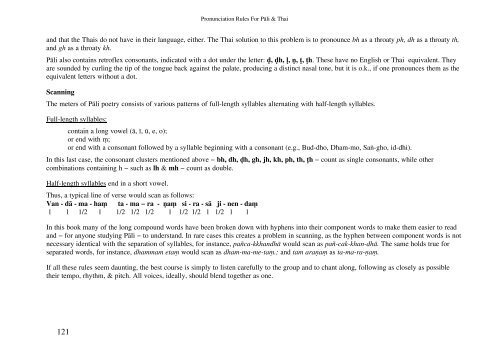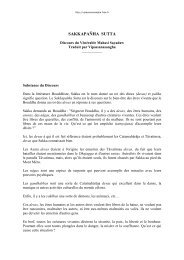Chomthong Chanting Book - Vipassanasangha - Free
Chomthong Chanting Book - Vipassanasangha - Free
Chomthong Chanting Book - Vipassanasangha - Free
Create successful ePaper yourself
Turn your PDF publications into a flip-book with our unique Google optimized e-Paper software.
Pronunciation Rules For Pāli & Thai<br />
and that the Thais do not have in their language, either. The Thai solution to this problem is to pronounce bh as a throaty ph, dh as a throaty th,<br />
and gh as a throaty kh.<br />
Pāli also contains retroflex consonants, indicated with a dot under the letter: ó, óh, ë, õ, ñ, ñh. These have no English or Thai equivalent. They<br />
are sounded by curling the tip of the tongue back against the palate, producing a distinct nasal tone, but it is o.k., if one pronounces them as the<br />
equivalent letters without a dot.<br />
Scanning<br />
The meters of Pāli poetry consists of various patterns of full-length syllables alternating with half-length syllables.<br />
Full-length syllables:<br />
contain a long vowel (ā, ī, ū, e, o);<br />
or end with ü;<br />
or end with a consonant followed by a syllable beginning with a consonant (e.g., Bud-dho, Dham-mo, Saï-gho, id-dhi).<br />
In this last case, the consonant clusters mentioned above − bh, dh, óh, gh, jh, kh, ph, th, ñh − count as single consonants, while other<br />
combinations containing h − such as lh & mh − count as double.<br />
Half-length syllables end in a short vowel.<br />
Thus, a typical line of verse would scan as follows:<br />
Van - dā - ma - haü ta - ma − ra - õaü si - ra - sā ji - nen - daü<br />
1 1 1/2 1 1/2 1/2 1/2 1 1/2 1/2 1 1/2 1 1<br />
In this book many of the long compound words have been broken down with hyphens into their component words to make them easier to read<br />
and − for anyone studying Pāli − to understand. In rare cases this creates a problem in scanning, as the hyphen between component words is not<br />
necessary identical with the separation of syllables, for instance, pañca-kkhandhā would scan as pañ-cak-khan-dhā. The same holds true for<br />
separated words, for instance, dhammam etaü would scan as dham-ma-me-taü.; and tam araõaü as ta-ma-ra-õaü.<br />
If all these rules seem daunting, the best course is simply to listen carefully to the group and to chant along, following as closely as possible<br />
their tempo, rhythm, & pitch. All voices, ideally, should blend together as one.<br />
121



